CHARACTERISTICS OF THE NERVOUS SYSTEM IN FOREIGN STUDENTS WITH DIFFERENT PHYSICAL ACTIVITY LEVELS
Abstract
Aim. To assess the reaction to light and sound stimuli of foreign students with different physical activity levels and provide the profile of their nervous system in the first year of their stay in Russia. Materials and methods. The study was carried out at the Department of Physical Education and Sports at RUDN University. The study involved 85 students, divided into 2 groups: students without any additional physical activity (n = 53) and students from sports groups (n = 32). Sensorimotor measurements were obtained as simple reaction time (light and sound) and complex reaction time (light). The characteristics of the nervous system were obtained with a tapping test. Results. A significant increase in simple reaction time (light and sound) was observed in students with low levels of physical activity compared with students from sports groups (P ˂ 0.01). The frequency of movements per unit of time among students with low levels of physical activity was rather low (49.50 ± 2.40) compared with students from sports groups (68.33 ± 2.55, P ˂ 0.01). Conclusion. In foreign students from sports groups, a strong nervous system was found. In foreign students with low levels of physical activity, sensorimotor reactions were worse, which indicates the instability of their psychophysiological reactions.
References
References on translit
Copyright (c) 2024 Human. Sport. Medicine

This work is licensed under a Creative Commons Attribution-NonCommercial-NoDerivatives 4.0 International License.















